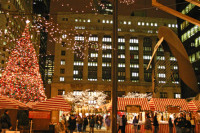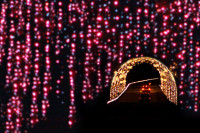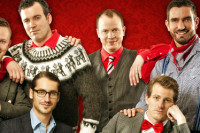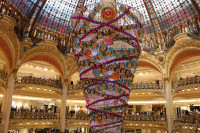Featured articles
A feeling of Christmas in the air: spiced cookies, festive drinks and foie gras
No matter what you do in December, it will be difficult to escape and resist the many specialities on display at your local supermarket or Christmas market.
The smell of spiced cooking and the endless varieties of cookies and festive food will help you through the grayish days of December.
Enjoy while you can!
WORLD SPECIALTIES – DRINKS
Glühwein – Vin Chaud (Germany, France, Nordic countries)
This is the drink that comes to mind when you think of Christmas markets while living in Northern Europe.
Whereever it is cold out, you will find Glühwein (literally glow wine) outside in the Christmas markets. What a great way to warm up while buying specialties and looking at the festive decorations!
But what is it made of? Red wine and spices such as cinnamon, cloves, vanilla and orange peels are found in Glühwein.
The wine should not be boiled but be warm up.
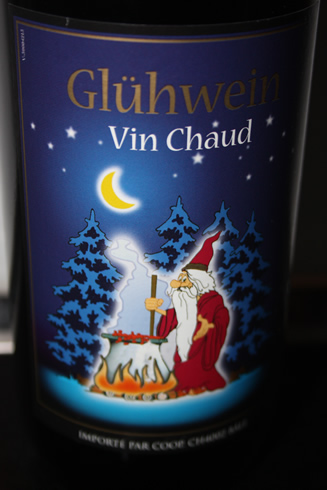
Glühwein – hot wine
In countries such as Norway, Finland and Denmark, other alcohol is added to the wine such as Vodka or Rum. It is known as Swedish Punch and called Glögg, Glögi or Glogg.
In Sweden a popular bottle of hot wine “Blossa Glögg”, made with red wine and spices such as cardamon, is sold. People there drink it while eating spiced cookies or dried raisins or almonds.
Since the Middle Ages it is a popular drink, beloved by the kings. It is well-known in Sweden since the end of the 19th century.
If you don’t have a Christmas market near you, check your local supermarket for a prepared bottle of Glühwein or make it yourself.
Christmas teas
Christmas teas are extremely beloved in Europe in the various Christmas markets. You can order them at the stands like you do for Glühwein or buy them at your supermarket in tea bags or in vrac. Purchased in colorful metal boxes, they make beautiful and ideal presents for the holidays.
If tea has been popular for ages, the term Christmas tea is still quite new. It is recently when the French tea company, Dammann Frères, bought the appellation in the 1990’s that it became more common to see Christmas teas. Now all of the major tea brands commercialize it.
What are the Christmas teas made of? You can find for instance orange and citrus peels, dried apples, red currants, rose-hips, vanilla, cherry blossom, almond, ginger, cardamon and cinnamon. The teas can be black, green or white. Sometimes the names of teas can really make you dream like: Once Upon a time for Christmas, One Christmas evening, Winter fairy tales and Christmas in Venise.
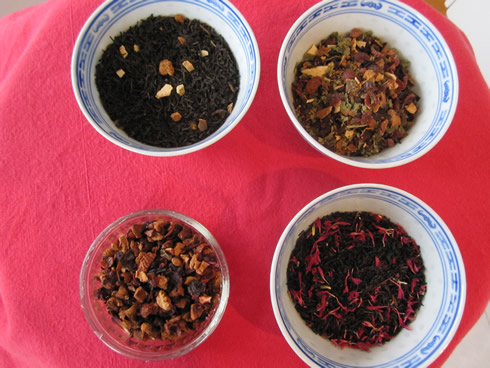
Various Christmas teas for the holidays
Champagne (France)
What bottle of wine will you open for New Year or Christmas? Probably Champagne.
Champagne is a sparkling wine from the eastern region of France called Champagne, produced from refermentation process.
For most people it is synonym of celebration and glamour. Just like Dom Pérignon who is believed to have said when drinking it: “I am drinking the stars”, many will be buying it again this year for the holidays. Champagne is quite beloved in France. Many drink it in apéritif, during the entire meal or just for dessert.
But who was Dom Pérignon? He was a French monk from the Champagne region living in the middle of the 17th century to early 18th. He had been believed to invent Champagne but in fact he suggested the blending of grapes and helped a great deal in the process of Champagne making.
When buying Champagne you can buy three kinds: Brut, extra Brut and Demi-Sec. For apéritif you should rather buy a Brut or extra Brut and keep the Demi-Sec for dessert as it has more sugar (33 to 55 g) instead of 7 to 15 g for Brut and 0 to 6 g for extra Brut.
To make Champagne one need to blend three grapes: Pinot noir, Pinot Meunier and Chardonnay.
Champagne production is limited compared to other wines like the Bordeaux. For instance, in 2005, it was produced on 31,800 hectares when there was 123,000 hectares for the wine of the Bordeaux region.
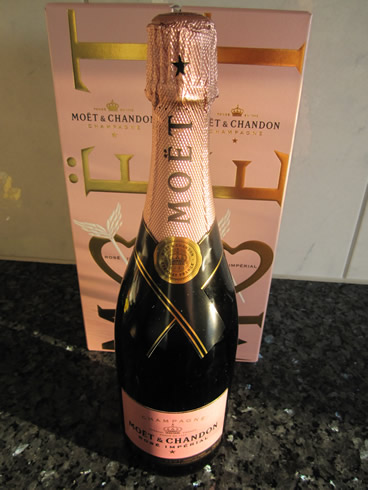
Fall in Love Bottle – Moet & Chandon
Have you noticed when you buy a bottle of Champagne you never have a date on it? It is normal unless the bottle is a Millésime such as Cuvée 2000.
Some big names like Moet & Chandon, Veuve Clicquot, Laurent Perrier-Jouet, Piper-Heidsieck, Lanson, Mercier and Tattinger, comes to mind when thinking of Champagne. The French don’t buy the expensive cuvées, the cuvées de luxe but the Brut. The expensive bottles are mainly sold overseas like to the US and to Japan.
However there are other bottles from other producers not as well-known but of good quality. One name is Canard du Chene.
In 2009, according to Magazine l’Hebdo, the producers of Champagne sold 10% less than usual during the first trimester. When times are difficult, other sparkling wines are bought and not Champagne. In Switzerland in shops like Coop and Globus, the trend has been noticed. In two decades it went from 10 millions of bottles bought to 5-6 millions! However, the Swiss still drink a lot of Champagne. In the world they are the third in consumption!
The Point Magazine revealed a couple good tips regarding drinking Champagne. First of all in order not to end up with a flying cork in your face, you need to hold the cork and turn the bottle. Champagne should not be served icy but between 8 C to 12 C depending on the bottle quality. 12 C for an old Champagne, 10 C for Millésime, 8 C for not a Millésime.
According to Interbrand’s research in September 2010, out of 100 international brands, Moet & Chandon falls in the 79th place. The brand came out this year for Valentine Day with the Fall in Love gift set, a bottle of Rosé Impérial. As well a Moet ice Impérial is now available; it is designed to be drunk icy.
Egg Nogg (Northern America, Canada and England)
The first time I had it, I was celebrating Christmas in England. I can’t say I like the drink but everyone around me seemed to enjoy drinking it at the party.
It is prepared with raw eggs, milk, cream, sugar and spices. For the holidays one adds some liquor to it like whiskey or rum. Rum was used in the US until the American Revolutionary War, when Americans could not find much Rum, they switched to Whiskey.
If you buy it at the supermarket, it will be sold to you without raw eggs. The look of egg Nogg is quite thick. Other use nutmeg or a bit of cinnamon.
WORLD SPECIALTIES – FOOD:
Gingerbread
When I think of the Christmas holidays, the soft gingerbread, the cookies from Nuremberg, the witches’ house from the fairy tale Hansel & Gretel and the little ginger cookie hanging in Christmas tree, come to mind.
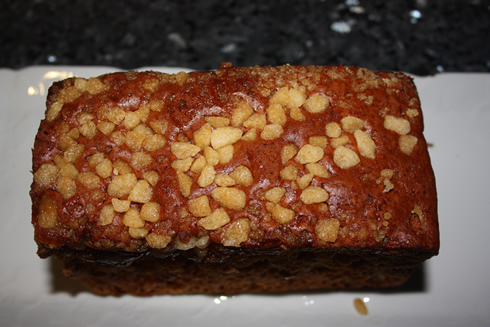
Soft gingerbread from Fortwenger – Pavé à l’ancienne
Without gingerbread the holiday season would not be the same!
What is it exactly? It is a sweet which can be hard or soft and made with honey and various spices like ginger.
Gingerbread has been known to Europeans since the 9th century when it came from India and China. It came to France in the 10th century. There, it is known as Pain d’épices and in Germany as Lebkuchen.
Before it was known as Honigkuchen, Pain au miel or honey Bread.
The famous Lebkuchen from Nuremberg have been made since the 11th century. They have various spices and white pepper in them. The town is known to have been famous for its pepper in the middle ages.
Gingerbreads were first made by priests, monks and nuns in Europe.
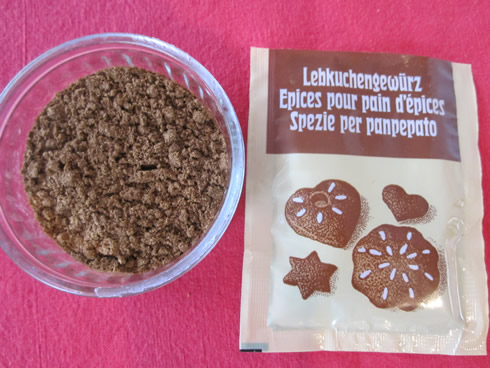
Gingerbread spices to make it yourself
In France the regions known for Pain d’épice are Alsace, Burgundy and Champagne. Towns like Strasbourg, Dijon and Reims come to mind.
Before gingerbread was known in Alsace and Burgundy, it was popular in Reims. In the dictionary in 1694, it was called Pain d’épice de Rheims and made with rye flour. To have the appellation Pain d’épice of Dijon, it has to be made with buckwheat.
If you are a fan of spice bread and you are traveling through the town of Gertwiller in the Alsace, then you should visit the palace of gingerbread, le Palais du Pain d’épices. This museum teaches you everything there is to know about it, using the five senses. The museum is owned by the old company of gingerbread, Charles Fortwenger.
While visiting the touristy villages of Riquewhir, you will notice in the pedestrian zone a Fortwenger store with many kind of gingerbread. It comes from the factory in Gertswiller, where 7 tons of gingerbread are made daily. Also other stores can be found in Kaysersberg and int the towns of Colmar and Strasbourg. I highly recommend trying the soft gingerbread from Fortwenger called Pavé à l’ancienne and the the nonnnettes with honey and orange marmalade.
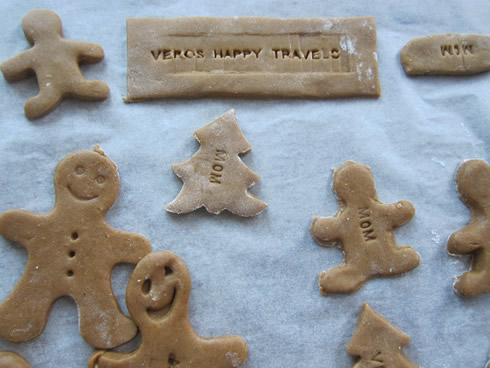
Gingerbread Mannele and other gingerbread cookies
Have you ever made a gingerbread house? If not try it out from scratch or you can buy the parts and glue them together. Gingerbread houses are sold in Switzerland and Germany and decorate bakery windows from November through December. When the brother Grimms wrote Hansel and Gretel in the 19th century, talking about a bread house, gingerbread became even more popular.
what about baking a gingerbread man for your Christmas tree?
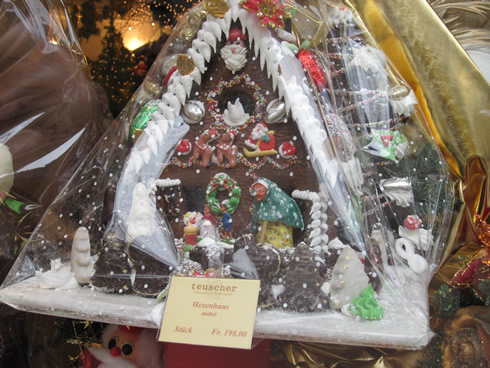
Gingerbread House inside of a candy shop in Zurich
Tirggel cookies (Switzerland)
The Tirggel cookies have been made in Switzerland since the 15th century (1461) and are extremely popular in the Swiss Christmas markets and up to April for the Sechseläutern festival.
The designs can have holiday scenes, zodiac signs, words, Swiss city monuments like the Zurich Grossmünster or the story of Wilhelm Tell. They are made with a small hole into them so that they can be hung in the Christmas tree. However you can buy them all year round but not just with holiday theme designs.
Again like many holiday cookies, the Tirggels are made with honey (main ingredient at 29%) and spices. They are baked in the canton of Zurich by Suter AG in Schönenberg, Honegger Tirggel and Migros.
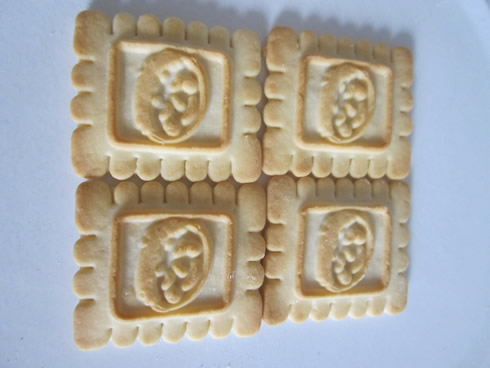
Tirggel cookies with Lemon from Suter AG Tirggel
The 30 years old, Carlo Magnano, whose father is Italian, bought the old Suter company in 2008. Since, he has innovated a few new cookies like the Biscrack or Tirggel with lemon or chocolate. Magnano would like the cookies to be eaten all year long just like Cantucci cookies. Right now the main season to make them is from September through December.
Suter used to be owned until 1972 by Willy Suter in Wädenswil. His family had started the business of Tirggel cookies in 1840. After 4 generations of Suter cookies, Peter Seibold took over the company in the 1970’s. Suter AG moved to Schönenberg above Samstagern and a road called Tirggelweg was made. In 2006 the company produced 70 tons annually, selling mainly to Switzerland, France and Germany.
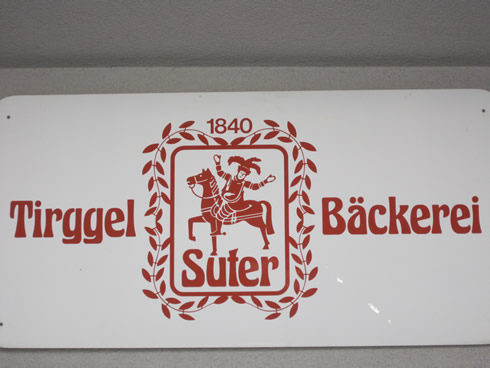
Front sign of the Tirggel Suter Bakery and Factory in Schönenberg
You can bake Tirggels at home in moulds but the temperature of your oven has to be extremely hot. Instructions vary from 752 F (400 C) for 90 seconds or about 1172 F (600 C) for less than a minute.
The shape of a Tirggel cookie is either round, rectangle or in a heart shape. All pieces have a tiny hole in them so you can hang them in your tree with a ribbon or a thread. The cookie characteristic is that it is extremely hard. If you bite into it, you may break a tooth! The secret to get to know the real honey flavor is to let it melt in your mouth.
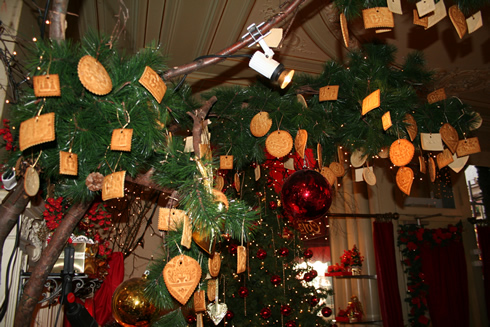
Christmas decoration with Tirggel cookies inside of a tearoom shop
Tirggels are not a Swiss invention. Recipes and molds were found in Mesopotamia and ancient Egypt. It was brought to Europe to the Romans before coming to Switzerland with the pilgrims to the cloister of Einsiedeln.
Spekulatius (Germany)
These German cookies from the Rheinland region are also known as Speculaas in the Netherlands and as Spéculoos in Belgium.
The main ingredients to make them are sugar, butter, flour and spices such as cinnamon, nutmeg, cardamon and ginger. The color of the cookie can be explained by the use of brown sugar instead of white sugar.
Sometimes you can also find them with slivered almonds. A particularity about these cookies is that it is extremely crispy. You can buy almond, spice or butter types of Spekulatius.
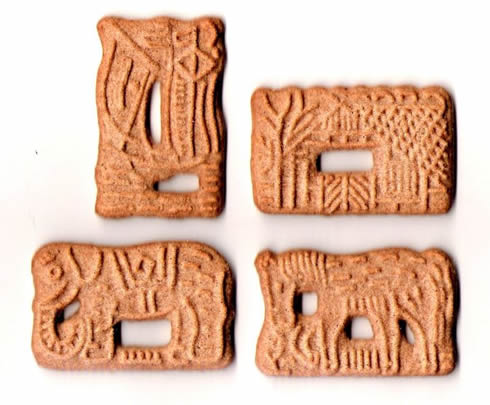
Four Spekulatius cookies – Vier Stücke Spekulatius @GFDL
The Spekulatius are rectangle cookies. They are made in molds and show scenes of the life of St. Nicholas, animals and windmills. Above all they are made for the eve and St. Nicholas Day on December 5th & 6th in Holland and Belgium and for the Christmas holidays in Germany.
Why are they called Spekulatius is not sure? Maybe to talk about the image reproduced in the mould or the bishop referring to St. Nicholas. The Latin word “speculum” means mirror and “speculator” means bishop.
Foie gras (France)
Being French, Christmas would not be Christmas without enjoying a slice of foie gras on a warm toast.
Just the thought of it and I have a smile on my face. Yum… I already picture myself tasting it with a glass of Beaume de Venise, Monbazillac or Sauternes.
If you are not familiar with Foie gras at all it means literally for “fat liver”. France is the major producer of foie gras in the world. Out of 25,500 tones produced in 2009, 18,820 tones were made in France, bringing a total turnover of 1.7 billion of Euros. Hungary is the second largest producer in the world.
When buying Foie gras since 1994, you buy “foie gras entier” (whole fat liver, “foie gras” or “bloc de foie gras”(block of fat liver, fully cooked), you can be sure it is only foie gras with seasoning. Foie Gras comes from duck or goose liver. A duck liver weighs much less than a goose liver, 15.8-21.1 oz. (450-600g) against 21.1-24.7 oz. (600-700g).
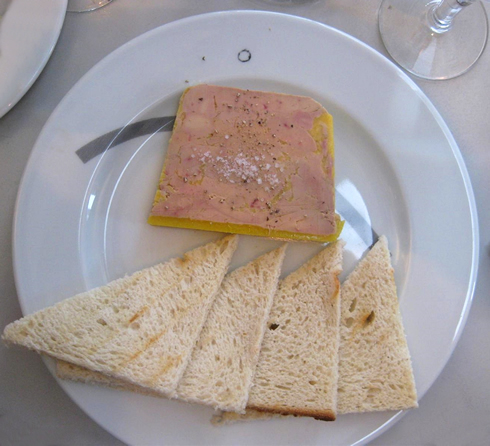
Slice of Foie Gras – Nick gray 3030960566
How is the liver ready? When the birds are about 3 months old, for 2 weeks, the farmers will check their alimentation carefully to build up good fat liver. The feeding process is considered cruel by some. Farmers use forced feeding with a tube to feed the animals corns. It is called gavage and only take 2-3 seconds. The birds will receive at the end of force feeding time before being killed up to 35 oz. (1000 g) a day, a big difference to the 8.8 oz. (250 g) at the beginning. Gavage lasts 12 to 15 days for the duck and a few days more for the goose.
Last year in 2009, the exportations of uncooked foie gras outside of France did not do so well in general compared to the previous year. There was a big increase for Bulgaria (180%), Italy (30%), Hong Kong (21%), but a decline for exportation toward the US (-69%), Japan
(-37%) and Russia (-67%). The consumption of cooked French Foie Gras (like pâté and mousse) outside of France remained the same. When it is cooked, it comes in a can or in glass containers.
In France, 80 % of the population eat Foie Gras for the holidays. They buy mainly duck liver at 92%.
The first Foie Gras of the year available for the celebration of St. Martin Day Mid of November. Since ages farmers celebrate eating gooses or ducks for instance. Martin died very beloved in 397 A.D. after having shared his cloth with a poor man, during a cold day.
Many French for the holidays make their own Foie Gras and eat it with fig jam and dried raisins.
The French were not the first ones to fatten goose and duck livers to make Foie Gras. One knows thanks to bas reliefs that the Egyptians already in 2500 B.C. were doing it. Then the Greeks and the Romans did the same thing. In France, the kings used to love it. It became really popular in the 18th century with corn production. One popular place to do Foie Gras tasting in France is in the Southwest in Périgord,where 90% of the production happens.

